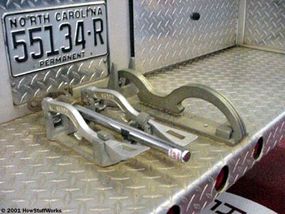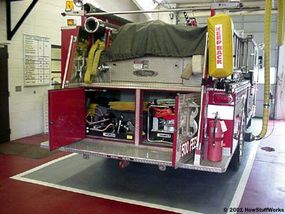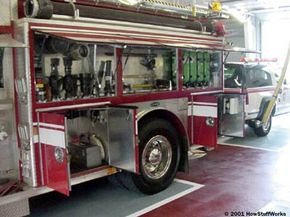The Ultimate Mobile Toolbox
Firefighters have to take dozens of tools and other equipment when responding to a fire or medical call. All of this equipment is stored in several compartments that line the sides and back of the fire engine.
Let's open up each compartment and see what's inside.
Advertisement
Here is a list of some of the tools found on a fire engine:
- Barrel strainer - This is an attachment put on a hard suction hose when sucking water out of a lake or pond. This tool keeps debris out of the water supply.
- Nozzles - Different nozzles are needed for different situations. Fog nozzles put out more of a strong mist of water. Other nozzles direct water in a solid stream. There's also a piercing nozzle that can be used to punch through walls and spray areas that can't be reached otherwise.
- Foam inductor - This is a special nozzle used to mix water and foam.
- Haligan tool - This tool looks similar to a crowbar.
- Sheet rock puller - This tool is used to peel back the sheet rock on walls so that water can be sprayed inside the wall.
- Pike poles - These spear-like tools are about 10 to 12 feet long and are thrust into the ceiling to pull sheet rock down.

- EMS equipment - Most fire engines carry a defibrillator, an emergency oxygen tank and a trauma jump kit, which includes all of the first aid equipment needed for emergencies.
- Gated Y - This special hose adapter can be attached to a line to allow two smaller lines to run off of the same water source.
- Spanner wrenches - These unique tools are used to tighten the lines to the fire engine or to a hydrant.

- Hydrant wrench - This is the wrench used to turn the hydrant on.
- Jaws of Life - This extrication equipment is used to free victims from car or building accidents. Read How the 'Jaws of Life' Work to learn more about these hydraulic machines.
- Exhaust fan - This fan is placed in the doorway to suck smoke out of the house. Fire engines may also carry a positive-pressure exhaust fan, which blows air through the house and out the other side.
- Salvage covers - These are used for covering furniture on a lower floor while firefighters attack a fire on a floor above.
In addition, fire engines also carry bolt cutters, a sledge hammer, a fire extinguisher, a water cooler, a 24-foot (7-m) extension ladder and a 16-foot (5-m) roof ladder. Some trucks may also carry chain saws, rappelling rope and backboards, which are used to transport injured people.

As you can see, there are a lot of tools and devices stored on a fire engine, and the design of the fire engine maximizes all possible storage space.
